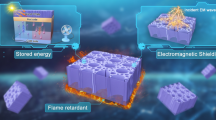Abstract
It is mainly studied that the smoke-suppression properties and synergistic flame-retardant effect of hollow glass microsphere (HM) in flame retardant thermoplastic polyurethane (TPU) composites based on ammonium polyphosphate (APP) as a flame-retardant. Also, the smoke suppression properties and flame-retardant effect were investigated by smoke density test (SDT), cone calorimeter test (CCT), limiting oxygen index, and thermogravimetric analysis, separately. The char residues left after CCT were examined by scanning electron microscopy. The data of SDT shows that HM could effectively decrease smoke production of TPU composites. The results of CCT reveal that the system of APP/HM could reduce heat release rate, smoke production rate, and total smoke release. It is shown that APP/HM is a good system with smoke-suppression and synergistic flame-retardant properties in flame-retardant TPU composites.















Similar content being viewed by others
References
Ainara S, Lorena R, Borja FA, Inaki M, Arantxa E, Angeles C. Thermoplastic polyurethanes from renewable resources: effect of soft segment chemical structure and molecular weight on morphology and final properties. Polym Int. 2013;62:106–15.
Pielichowski K, Leszczynska A. TG-FTIR study of the thermal degradation of polyoxymethylene (POM)/thermoplastic polyurethane (TPU) blends. J Therm Anal Calorim. 2004;78:631–7.
Chen PH, Yang YF, Lee DH, Lin YF, Wang HH, Tsai HB, Tsai RS. Synthesis and properties of transparent thermoplastic segmented polyurethanes. Adv Polym Technol. 2007;26(1):33–40.
Barick AK, Tripathy DK. Nanostructure morphology and dynamic rheological properties of nanocomposites based on thermoplastic polyurethane and organically modified montmorillonite. Polym Bull. 2011;66:1231–53.
Zhao KM, Xu WZ, Song L, Wang BB, Feng H, Hu Y. Synergistic effects between boron phosphate and microencapsulated ammonium polyphosphate in flame-retardant thermoplastic polyurethane composites. Polym Adv Technol. 2012;23:894–900.
Kang SH, Ku DC, Lim JH, Yang YK, Kwak NS, Hwang TS. Characterization for pyrolysis of thermoplastic polyurethane by thermal analyses. Polym Soc Korea. 2005;13:212–7.
Zhang Q, Chen YH. Synergistic effects of ammonium polyphosphate/melamine intumescent system with macromolecular char former in flame-retarding polyoxymethylene. J Polym Res. 2011;18:293–303.
Wang JC, Yang K, Zheng XY. Studies on the effect of 4A zeolite on the properties of intumescent flame-retardant agent filled natural rubber composites. J Polym Res. 2009;16:427–36.
Wang JH, Liang GZ, He SB, Yang LL. Curing behavior and mechanical properties of hollow glass microsphere/bisphenol a dicyanate ester composites. J Appl Polym Sci. 2010;118:1252–6.
Tryana VG, Masami N. On a hybrid method to characterize the mechanical behavior of thin hollow glass microspheres. Granular Matter. 2012;14:309–18.
Zou YK, Zhan YQ, Zhao R, Liu XB. Low dielectric permittivity and high thermal stability composites based on crosslinkable poly (arylene ether nitrile) and hollow glass microsphere. J Mater Sci-Mater Elem. 2013;24:1238–42.
Bian XC, Tang JH, Li ZM. Flame retardancy of hollow glass microsphere/rigid polyurethane foams in the presence of expandable graphite. J Appl Polym Sci. 2008;109:1935–43.
Wang XY, Li Y, Liao WW, Gu J, Li D. A new intumescent flame-retardant: preparation, surface modification, and its application in polypropylene. Polym Adv Technol. 2008;19:1055–61.
Chen XL, Jiao CM. Flammability and thermal degradation of epoxy acrylate modified with phosphorus-containing compounds. Polym Adv Technol. 2010;21:490–5.
Park WH, Yoon KB. Optimization of pyrolysis properties using TGA and cone calorimeter test. J Therm Sci. 2013;22(2):168–73.
Daisuke K, Katsushi K, Mariko I, Satoshi K, Takahiro Y. Evaluation of combustion properties of wood pellets using a cone calorimeter. J Wood Sci. 2009;55:453–7.
Chen XL, Jiao CM. Flame retardancy and thermal degradation of intumescent flame retardant polypropylene material. Polym Adv Technol. 2011;22:817–21.
Jiao CM, Chen XL. Flammability and thermal degradation of intumescent flame-retardant polypropylene composites. Polym Eng Sci. 2010;10:767–72.
Schartel B, Hull TR. Development of fire-retarded materials—interpretation of cone calorimeter data. Fire Mater. 2007;31:327–54.
Lin M, Li B, Li QF, Li S, Zhang SQ. Synergistic effect of metal oxides on the flame retardancy and thermal degradation of novel intumescent flame-retardant thermoplastic polyurethanes. J Appl Polym Sci. 2011;121:1951–60.
Almeras X, Le Bras M, Hornsby P, Bourbigot S, Marosi G, Keszei S, Poutch F. Effect of fillers on the fire retardancy of intumescent polypropylene compounds. Polym Degrad Stabil. 2003;82:325–31.
Dong YY, Gui Z, Hu Y, Wu Y, Jiang SH. The influence of titanate nanotube on the improved thermal properties and the smoke suppression in poly(methyl methacrylate). J Hazard Mater. 2012;209:34–9.
Carty P, Creighton J, White S. TG and flammability studies on polymer blends containing acrylonitrile-butadiene-styrene and chlorinated poly(vinyl chloride). J Therm Anal Calorim. 2001;63:679–87.
Ricciardi MR, Antonucci V, Zarrelli M, Giordano M. Fire behavior and smoke emission of phosphate-based inorganic fire-retarded polyester resin. Fire Mater. 2012;36:203–15.
Dias DS, Marisa SC, Kobelnik M, Ribeiro CA. Calorimetric and SEM studies of PHB–PET polymeric blends. J Therm Anal Calorim. 2009;97:581–4.
Jiao CM, Chen XL, Zhang J. Synergistic effects of Fe2O3 with layered double hydroxides in EVA/LDH composites. J Fire Sci. 2009;27:465–79.
Fang SL, Hu Y, Song L, Zhan J, He QL. Mechanical properties, fire performance and thermal stability of magnesium hydroxide sulfate hydrate whiskers flame retardant silicone rubber. J Mater Sci. 2008;43:1057–62.
Cecen V. Thermophysical properties of composites formed from ethylene-vinyl acetate copolymer and silver-coated hollow glass microspheres. J Appl Polym Sci. 2011;122:685–97.
Murugasamy K, Bhagawan SS, Sabu T, Kuruvilla J. Thermogravimetric analysis and differential scanning calorimetric studies on nanoclay-filled TPU/PP blends. J Therm Anal Calorim. 2013;112:1231–44.
Zhang Y, Chen XL, Fang ZP. Synergistic effects of expandable graphite and ammonium polyphosphate with a new carbon source derived from biomass in flame retardant ABS. J Appl Polym Sci. 2013;10:2424–32.
Acknowledgements
The authors gratefully acknowledge the supports received from the National Natural Science Foundation of China (No. 51106078, No. 51206084), and the Out-standing Young Scientist Research Award Fund from Shandong Province (BS2011CL018).
Author information
Authors and Affiliations
Corresponding author
Rights and permissions
About this article
Cite this article
Chen, X., Jiang, Y. & Jiao, C. Synergistic effects between hollow glass microsphere and ammonium polyphosphate on flame-retardant thermoplastic polyurethane. J Therm Anal Calorim 117, 857–866 (2014). https://doi.org/10.1007/s10973-014-3831-2
Received:
Accepted:
Published:
Issue Date:
DOI: https://doi.org/10.1007/s10973-014-3831-2




